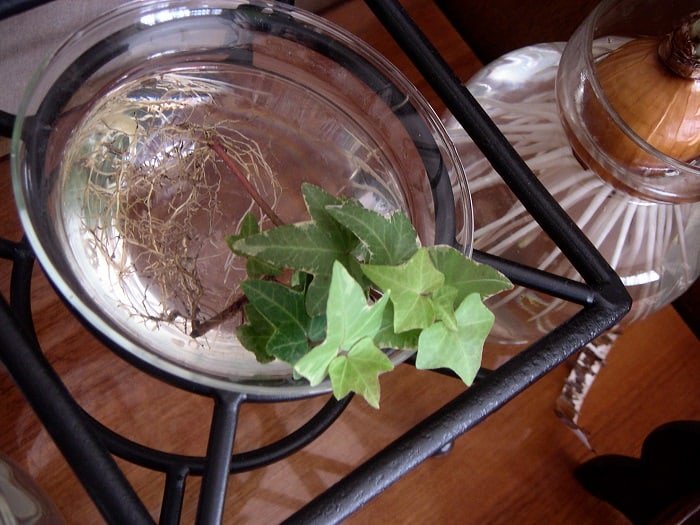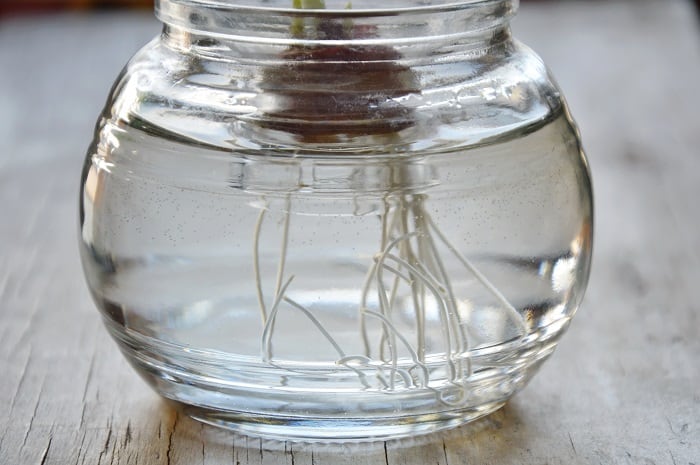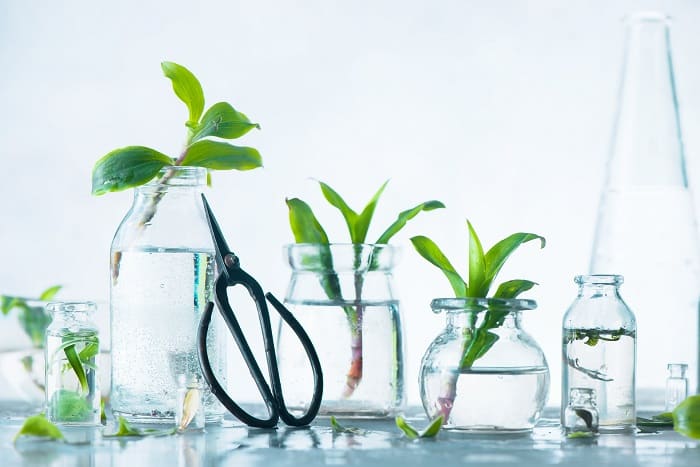Have you ever seen a plant that you feel so in love with you simply HAD to grow it at home? Well, that is a perfectly normal feeling and you can definitely do it very easily. This method of reproduction or cloning is called “cutting” and basically consists of – you guessed it – cutting a part of a plant to create a new one. Today we are going to discuss how to use a rooting powder in water to reproduce your own or other plants!
You could use this method to create another plant to gift a friend that lives far away or to reproduce a beautiful flower you found at a park. Remember, though, to always ask permission to take a cutting from a private location and NEVER! do this in a store. That would actually be stealing!
What is Rooting Powder?
You may have heard the name at your local specialty garden or hydroponics supply shop. Powder rooting hormones are commercially available supplements to help with exactly that – rooting!
Plants use hormones just like our bodies do. They tell the plant what to do: root, bear fruit, flower, grow leaves. We are particularly interested in auxins, the type of hormones that tell the plant to root.
There are a couple of synthetic chemicals that can replace the effect of auxins on plants. They can help promote the growth of new roots.

Although they are best used when you are cutting a part from another plant to clone it in a new pot, they could also be beneficial in other growth stages.
If you use them, the root of the new clone will develop quicker and be of better quality than if you had not used any kind of supplement. This makes it easier to propagate any type of plant, not just those that root easily.
Rooting hormones come in different presentations like gel or liquid, but today we are going to discuss their powder form.
How to Use Rooting Powder
Dosage is the tricky part of it all. If you use too little, it will be as if you had not used any. But if you overdo it, you could have the opposite effect and actually make the plant yellow and wither.
To use the powder, put some of it in a small container. Grab the cutting and dip the end into the powder. Make sure the bottom ½ inch is free of any leaves before doing this. Then shake off the excess and place it into a glass of water to start it.
You should have a thin film of powder that does not exceed a quarter of an inch from the base of the stem. Keep in mind that if the cutting is wet or has little hairs it will pick up too much powder. Make sure it is dry and you double tap it in case of little hairs.
As a general tip, if you are doing this on more than one cutting at a time, replace the powder each time so as not to transmit any diseases from one cutting to the next.
How to Create a Cutting
You will need a clean, shark knife or scissors. Do not use blunt cutters as they will hurt the plant.
Plants that root in water usually have nodes, like vines for example. They will root more easily in water, so you should maybe try them first! In any case, with the help of the rooting powder you could try any plant.
First, identify where you are going to cut. Aim for ¼ of an inch below the node. Then dip your cutting into the rooting powder as described above.
Afterwards, put your cutting into a clean glass. Pour enough room temperature water to make it so that it covers the cutting’s nodes.
You should switch the water every 3 to 5 days. Keep it fresh! We recommend using tap water at room temperature. If there are tiny roots already, clean the slimy film off them before placing them back into water. Also, always remember to keep the forming roots under water.

Depending on the plant, rooting can take from only a couple of weeks to a couple of months. The powder will definitely help but be patient!
Once the roots reach 5 inches in length, you can place the cutting into some
Put the cuttings near a window where they do not get hit by direct sunlight but are still in a bright area.
Some Tips on Cuttings
Some cuttings need to be aired out or “hardened” a few days before being placed in water. This is true, for example, for geraniums. You should do this in an area without direct sunlight over newspaper or paper towels in a place with a steady 65 to 75°F temperature.
Make sure your cutting has enough leaves on it to perform photosynthesis. It does not need a lot, just a few so that the cutting can benefit from the sunlight. This ratio is also dependent on the season. In Winter you will want more leaves on your cutting than in Summer.
FAQ’s
Can I water plants with rooting powder?
There are lots of different ways to root plants. Rooting powder is used to speed up the process of rooting plants. You put a little on your soil, and let your cuttings root in it for a few days. Rooting powder is used by professionals and homeowners for propagating plants. I have found that the best way to root cuttings is to use a rooting hormone. It is available at nurseries and home improvement stores. Rooting hormone will keep your plants roots healthy and happy. They will be able to absorb nutrients better, they won’t get root bound, and they won’t dry out. The only disadvantage of using rooting hormone is that it must be used immediately after rooting your plant. If you wait until the next day to apply rooting hormone, it will not work as well. I have seen people recommend using both products. They say that they mix them together and then use the mixture. That doesn’t seem like a good idea to me. I think you would need a lot of rooting powder to get any effect.
If you can’t find rooting powder, a 1/2 cup of baking soda and 1/4 cup of cornstarch should do just fine.
Do cuttings need light to root?
Cuttings need light, but not direct sunlight. Cuttings can be rooted in a pot on a windowsill or inside a house, as long as they have good light. Cuttings should be kept moist. If you’re using a houseplant container, place the cutting so that it is touching the bottom of the pot, not sitting in water.
It’s important to keep the roots warm because they are growing and the leaves are expanding. You can add heat to the pot with a heater bulb, but don’t put a heater directly on top of the cutting.
Can I put fertilizer in water propagation?
Yes, you can. If you want to feed your seedlings, you need to do it very slowly, using a watering can and a fine mist sprayer. If you want to fertilize the soil, you can use fertilizer that is water soluble, such as fish emulsion or fish emulsion plus.
It’s important that you do not apply the fertilizer with a hose, because the fertilizer will run off into the soil.
Why do cuttings fail?
There are many reasons why plant cuttings fail. Either it did not root because it was too small or the root system is too weak to survive the environment it is placed in., or too much light Plants require a certain amount of light, which they use for photosynthesis, to grow and form roots. When plants are exposed to too much light, they become leggy and spindly. This is caused by a lack of chlorophyll. A change in the weather can have an effect on plant growth. For example, when the temperature rises, plants will often become more active.
Why Use Cuttings and Not Seeds?
Although growing a plant from a cutting takes serious patience, it is really much easier and a shorter wait than doing it by growing a seed. Also, some seeds are difficult to germinate.
Growing cuttings in water is much easier and yields more consistent results, as you are cloning the plant from which you took the cutting in the first place.

Choosing to grow them in water is also great for plant health, as it reduces the risk of the plant contracting some fungus or soil gnats.
What do you think? Will you try growing your own cuttings in water using rooting powder? Tell us below what have been your experiences with this product and post a picture of your favorite plant you have propagated using this method. For us it has worked wonders!

Josephine is an enthusiastic gardener who loves to spend her spare time tending to her garden. She is passionate about growing her own food, and aspires to one day have her own vegetable garden. Josephine is also an animal lover and often takes in stray cats and dogs. She enjoys spending time with her pets in the garden, and is often seen playing with them or watering her plants. Josephine is an avid reader and enjoys learning about new gardening techniques and plants. She is always looking for ways to improve her garden and make it more beautiful. She is a great friend, always willing to lend a helping hand when needed. Josephine‘s passion for gardening and love of animals make her a wonderful addition to any garden.




